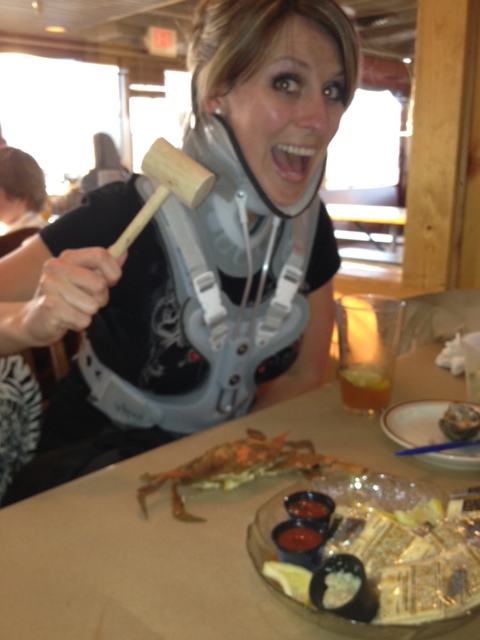
My sister sent me this new site that has so much helpful information on it. It has this question and answer session with doctors and one of the neurosurgions is the surgion doing my surgery in NY, Dr B.
http://chiariconnectioninternational.com/doctor.php
Here is some of the info I found interesting:
Fibromyalgia, Chronic Fatigue, and CM
Fibromyalgia (FM) and Chronic Fatigue Syndrome are "wastebasket diagnoses".
In a nutshell, they mean:
1. You have pain all over (FM) or you have a low energy level (CFS), in the absence of an identifiable diagnosis.
2. For convenience reasons (and to give the patients some sense of closure), we give these conditions a label (FM and CFS).
Many disorders can cause symptoms which mimic or overlap those of FM and CFS. If you have multiple metastatic lesions in your bones, you will hurt all over. If you have advanced lung cancer, you will be very fatigued even when coping with the normal activities of daily living.
Chiari I Malformation has a clinical presentation which can possibly involve several symptoms, besides the classically accepted Suboccipital pressure headache aggravate by exercise and straining. Diffuse body pain and fatigue are among the symptoms of the CMI spectrum. The electrical circuitry behind these FM-like and CFS-like symptoms is poorly understood, but they indeed improve in several patients after uncomplicated surgery, to various degrees.
The controversy about FM, CFS, and CMI started a decade ago, when the official ranks of organized neurosurgery had the impression that some physicians were overdoing posterior fossa decompression, to provide a tentative "cure" for FM (and/or CFS). The high profile of some media exposures (a 20/20 segment, and an article on the Wall Street Journal) added fuel on the fire. The result was a backlash which affected some professional carriers (with sanctions), put FM and CFS in a murky and off-limit perspective to the American neurosurgeons, and caused a steering towards the right in the overall surgical management of CMI (with most of the experts shifting towards highly conservative criteria for diagnosis and treatment).
Attempts had been made recently to restart the analysis of this highly charged problem. NFRA (National Fibromyalgia Research Association) is the ASAP equivalent for FM. Like ASAP, they have an annual meeting. Dr Rosner (who is back to surgical activity in NC) is a frequent presenter at the NFRA meetings. On occasion of the last NFRA meeting, the preliminary results (meta-analysis) of a study conducted by a group of scientists from the University of Seattle WA (led by Dr Ellenbogen) have been presented; the preliminary data suggested that in their patient population there was an increased association between FM and "borderline CMI " (= minimal tonsillar herniation).
Bottom line:
The relationship between FM, CFS, and CMI is very complex, poorly understood, inadequately investigated, and highly controversial. The topic has been a taboo for neurosurgeons during the last decade. Recently, the problem is being reapproached, in a less emotional and more logical manner.
Paolo Bolognese, MD
*********************************************************
If we wait to have surgery for Tethered Cord Syndrome (TCS), will we have nerve damage?
TCS acts by pulling downwards the inferior end of the spinal cord with a tight (and sometimes thick) filum terminale (which is the rubber band anchoring the spinal cord to the tailbone). The downward pull distorts the area of the cord called conus, causing lower back pain, leg pain, feet numbness, urinary disturbances, and bowel problems.
The natural history of the disease sees the filum pulling, and the spinal cord giving, over the lifetime. The growth spurts of adolescence cause cyclic acute flareups of the TCS symptoms and signs, with severe "growing pains", and bladder and bowel "accidents". When the skeletal growth ends and the subject enters adult life, the balance between tight filum and cord is played over a slower pace, with a slow clinical progression of the signs and symptoms.
In this adult phase (on the grounds of our experience) there is a point of no return, beyond which permanent damage can be left behind even after surgical correction. The exact timing of this point in time is still unclear, but some warning signs are already emerging:
- The urodynamically confirmed diagnosis of neurogenic bladder; - EMG changes in the legs (when not connected to other pathologies); - Foot drop (even when only mild).
TCS can affect the bladder in two ways:
- Hypoactive bladder (with urinary retention) - Hyperactive bladder (with urinary frequency), often mixed with dyssinergia (the bladder contracts without proper coordination). Hypoactive and dyssinergic bladders can lead to hydronephrosis (= a dilation of the major urine channels within the kidneys), which can ultimately cause renal insufficiency.
Our experience is based on a quite large patients' basis. 220 TCS surgeries have been performed at TCI, during the year 2006 alone. During the same year, many other patients have been diagnosed at TCI with milder forms of TCS, but not treated surgically. We have also observed that the majority of the TCS pts diagnosed at TCI had an associated connective tissue disorder (like EDS or Marfan). Patients with a diagnosis of connective tissue disorder (and specially people who underwent craniocervical fusions in the past) need to be screened for TCS.
Paolo Bolognese, MD

No comments:
Post a Comment